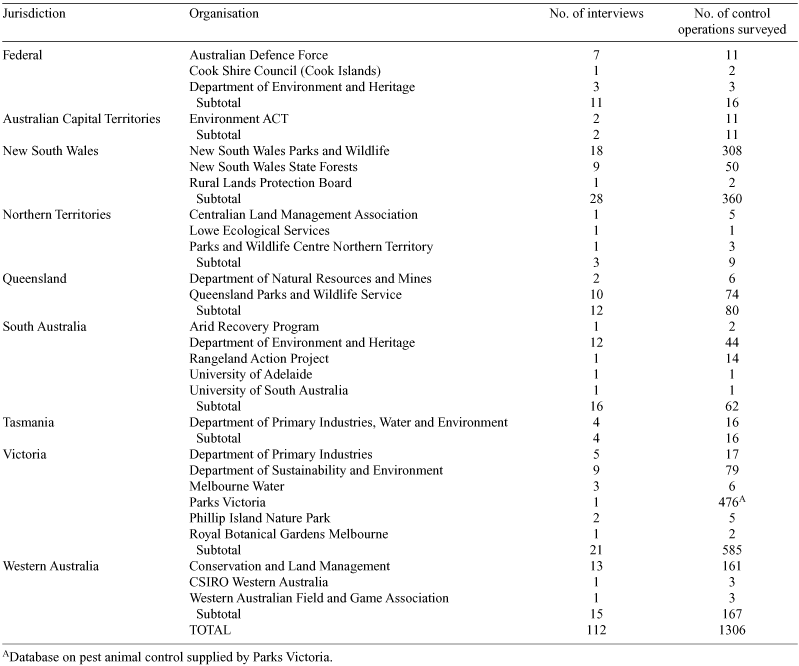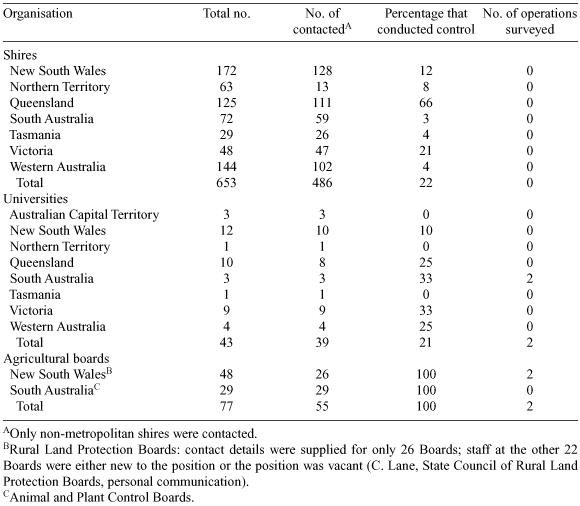Control of pest mammals for biodiversity protection in Australia. I. Patterns of control and monitoring
Ben Reddiex A , David M. Forsyth B F , Eve McDonald-Madden B D , Luke D. Einoder B E , Peter A. Griffioen C , Ryan R. Chick B and Alan J. Robley BA Landcare Research, PO Box 69, Lincoln 7640, New Zealand. Present address: Department of Conservation, Wellington Conservancy, PO Box 5086, Wellington, New Zealand.
B Arthur Rylah Institute for Environmental Research, Department of Sustainability and Environment, PO Box 137, Heidelberg, Vic. 3084, Australia.
C Acromap Pty Ltd, 37 Gloucester Drive, Heidelberg, Vic. 3084, Australia.
D Present address: The Ecology Centre, School of Integrative Biology, The University of Queensland, St Lucia, Qld 4072, Australia.
E Present address: South Australian Research and Development Institute (Aquatic Sciences), PO Box 120, Henley Beach, SA 5022, Australia.
F Corresponding author. Email: dave.forsyth@dse.vic.gov.au
Wildlife Research 33(8) 691-709 https://doi.org/10.1071/WR05102
Submitted: 16 November 2005 Accepted: 20 October 2006 Published: 19 December 2006
Abstract
Foxes, wild dogs, feral cats, rabbits, feral pigs and feral goats are believed to have deleterious impacts on native biodiversity in Australia. However, although considerable resources have been expended controlling these six species, little is known about national patterns and costs of control and monitoring. We therefore conducted a survey of pest-control operations undertaken by conservation-focused organisations in Australia. A total of 1306 control operations were reported, with most conducted during 1998–2003: there was little information prior to 1990. Foxes and rabbits were the most, and feral cats the least, frequently controlled pest species. The total area on which control was undertaken in 2003, the year for which most information was available, ranged from ~0.4 × 104 km2 for feral cats to ~10.7 × 104 km2 for foxes. A wide range of techniques and intensities were used to control each of the six species. The estimated cost of labour expended on control in 2003 ranged from $0.4 × 106 for feral cats to $5.3 × 106 for foxes. Monitoring of the pest or biodiversity occurred in 50–56% of control actions in which foxes, wild dogs and feral cats were targeted, but only 22–26% of control actions in which rabbits, feral pigs and feral goats were targeted. Our results are discussed in relation to previous studies of pest animal control and monitoring in Australia.
Acknowledgments
This study was funded by the Department of the Environment and Heritage. We thank all the individuals, too numerous to list here, who kindly provided information: without them this study would not have been possible. We thank P. Macak and K. Long for assisting with data collection, G. Swanson and G. Heard for assisting with data entry, and M. Scroggie for assisting with the preparation of some figures. M. Bomford and Q. Hart kindly clarified the methods used to estimate their costs. Comments by S. Wright, D. McRae, T. Clancy, P. Cowan, J. Parkes and two anonymous reviewers greatly improved this manuscript.
Algar, D. , and Smith, R. (1998). Approaching Eden. Landscape 15, 337–341.
Bomford, M. , and O’Brien, P. (1995). Eradication or control for vertebrate pests? Wildlife Society Bulletin 23, 249–255.
Burbidge, A. A. , and McKenzie, N. L. (1989). Patterns in the modern decline of Western Australia’s vertebrate fauna: causes and conservation implications. Biological Conservation 50, 143–198.
| Crossref | GoogleScholarGoogle Scholar |
Edwards, G. P. , de Preu, N. D. , Shakeshaft, B. J. , and Crealy, I. V. (2000). An evaluation of two methods of assessing feral cat and dingo abundance in central Australia. Wildlife Research 27, 143–149.
| Crossref | GoogleScholarGoogle Scholar |
Fleming, P. J. S. (1997). Uptake of baits by red foxes (Vulpes vulpes): implications for rabies contingency planning in Australia. Wildlife Research 24, 335–346.
| Crossref | GoogleScholarGoogle Scholar |
Forsyth, D. M. , Hone, J. , Parkes, J. P. , Reid, G. , and Stronge, D. (2003). Feral goat control in Egmont National Park, New Zealand, and the implications for eradication. Wildlife Research 30, 437–450.
| Crossref | GoogleScholarGoogle Scholar |
Pech, R. P. , Sinclair, A. R. E. , Newsome, A. E. , and Catling, P. C. (1992). Limits to predator regulation of rabbits in Australia: evidence from predator-removal experiments. Oecologia 89, 102–112.
| Crossref | GoogleScholarGoogle Scholar |
Reddiex, B. , and Forsyth, D. M. (2006). Control of pest mammals for biodiversity protection in Australia. II. Reliability of knowledge. Wildlife Research 33, 711–717.
Saunders, G. , Harris, S. , and Eason, C. T. (1993). Iophenoxic acid as a quantitative bait marker for foxes. Wildlife Research 20, 297–302.
| Crossref | GoogleScholarGoogle Scholar |
Saunders, G. , Kay, B. , and McLeod, L. (1999). Caching of baits by foxes (Vulpes vulpes) on agricultural lands. Wildlife Research 26, 335–340.
| Crossref | GoogleScholarGoogle Scholar |
Thomson, P. C. , and Algar, R. (2000). The uptake of dried meat baits by foxes and investigations of baiting rates in Western Australia. Wildlife Research 27, 451–456.
| Crossref | GoogleScholarGoogle Scholar |
Zavaleta, E. S. , Hobbs, R. J. , and Mooney, H. A. (2001). Viewing invasive species removal in a whole-ecosystem context. Trends in Ecology & Evolution 16, 454–459.
| Crossref | GoogleScholarGoogle Scholar |


|

|


